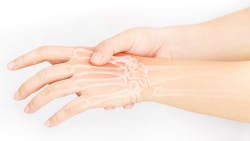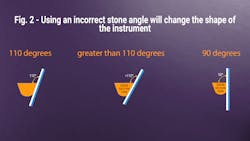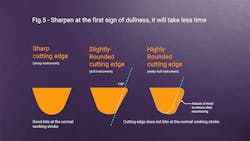Dull instruments and hand injury to the hygienist: There's a connection
Deborah McGlynn, BS, RDH
When using dull, poorly sharpened instruments, the hygienist must grip and push harder on the instrument in order to get it to engage on the tooth. Most of the time, the hygienist’s wrist will come out of the neutral position. Hygienists must begin to realize the impact this has on their hands and longevity in their careers. We must create good habits to maintain sharp instruments. Sharpening must become standardized and calibrated in order to prevent hand injuries to hygienists.
Dental hygienists are known to be at high risk for work-related injuries to their hands.1 Musculoskeletal disorders (MSD) reported by hygienists are caused by repetitive motion, poor ergonomics, and pushing and gripping the instrument too hard.2
When hygienists use dull instruments, not only do they have to push harder and grip harder, but when the instrument is poorly sharpened, not sharpened, or incorrectly sharpened, the wrist will come out of the neutral position in an attempt to get the instrument to “bite” the tooth surface. Over time, this repeated action leads to inflammation and injury.
The characteristics of incorrectly sharpened instruments include bevels, or facets, being formed on the lateral surfaces, and changes in the shape of the instrument caused by using the wrong sharpening angle.
Why is this such a problem? Why are hygienists working with poorly sharpened, dull instruments?
According to a survey published in the September 1, 2018, issue of RDH magazine, 49% of hygienists claim they have a lack of confidence in sharpening properly, and 72% said they have a lack of time.3
In an April 14, 2015, RDH magazine article, Lory Laughter, RDH, BS, speculated that hygienists suffer a loss of sharpening skill over time after graduation.4
The only way to assure you maintain the instrument’s sharp cutting edge is to sharpen chairside while you are working on the patient.5
A study published in 1985 found that an instrument typically loses its edge after only 15 strokes.6 The best use of our time is to keep the instrument sharp chairside. The minute it begins to lose its edge, stop and sharpen. It is quick and only takes a few strokes to bring the cutting edge back up. This keeps the instrument in shape so you’re not working too hard, and you’re providing the best care to the patient.
Hygienists believe they don’t have enough time to sharpen while treating patients. When the instruments get too dull, they require recontouring. Recontouring requires time. It takes more than a few strokes to get instruments sharp again. In the below schematic (fig. 5), you can see the dull, rounded edge. In order to get it back to its original shape, look how much metal must be removed! When hygienists say, “I don’t have enough time to sharpen,” they are unconsciously saying to themselves, “I’m willing to work harder.” This belief must be shifted if hand injury statistics are to change for the better.
If hygienists are going to take responsibility for decreasing hand injury by sharpening instruments at the first sign of dullness, they must find a way to identify their lack of confidence and strengthen their sharpening skill. It is a skill that is just as important as our skills in scaling, periodontal assessment, taking x-rays, etc. There are several guides/devices, as well as instruments that hold an edge longer and training courses available to provide this help.
The latest technology available is DH Cubed’s OneTen Sharpening System, which includes sharpening training modules and the OneTen sharpening guide. The modules are designed to train and retrain the hygienist in the skill of sharpening. This supports hygienists who don’t have confidence in their sharpening skills. The OneTen sharpening guide helps the hygienist consistently keep the correct angle in order to maintain the shape of the instrument. The result is a surgically sharp cutting edge that is easy to keep sharp, reducing the time needed to sharpen. You can find more information by going to www.dhcubed.com.
If hygienists are going to take action to reduce and prevent work-related injury, they must make it a priority to work with sharp instruments.
References 1. Lalumandier JA, McPhee SD. Prevalence and risk factors of hand problems and carpal tunnel syndrome among dental hygienists. J Dent Hyg. 2001;75(2):130–134. Millar D. Adverse effects of MSD affect dental hygienists. ISHN website. https://www.ishn.com/articles/105008-adverse-effects-of-msd-affect-dental-hygienists. Published October 3, 2016. Accessed March 30, 2019.
2. DeStefano AW. The ballad of time, money, and instrument sharpening. RDH magazine website.https://www.rdhmag.com/articles/print/volume-38/issue-9/content/the-ballad-of-time-money-and-instrument-sharpening.html. Published September 1, 2018. Accessed March 30, 2019.
3. Laughter L. Your best efforts! Author’s informal survey indicates that dental hygienists do not retain sharpening skills. RDH magazine website. https://www.rdhmag.com/articles/print/volume-35/issue-4/features/your-best-efforts.html. Published April 14, 2015. Accessed March 30, 2019.
4. Pascoe R. Three reasons why you should sharpen dental instruments chair-side. Dentaltown website. web.archive.org/web/20170802004740/https:/www.dentaltown.com/blog/post/1995/3-reasons-why-you-should-sharpen-dental-instruments-chair-side. Published February 27, 2015.
5. Vavrosky K. Ask Kara RDH: How often should I sharpen my instruments? Today’s RDH website.https://www.todaysrdh.com/ask-kara-rdh-how-often-should-i-sharpen-my-instruments/. Published April 4, 2018.
Deborah McGlynn, RDH, BS, is the chief education officer of DH Cubed. She has been a dental hygiene educator since 1988 and started a dental hygiene tutoring business in 2001. Deborah has been a practicing hygienist since 1981. She gives presentations on the ergonomics of sharpening in dental hygiene. If interested in having her speak, please contact her at [email protected]




